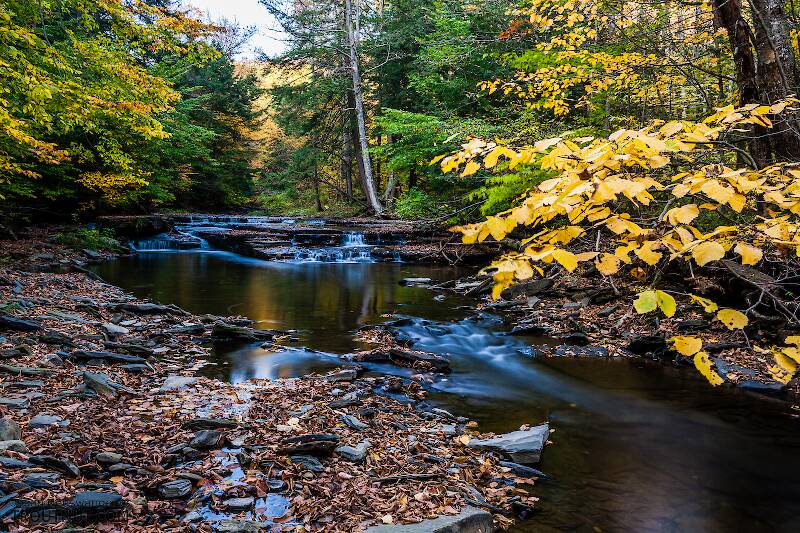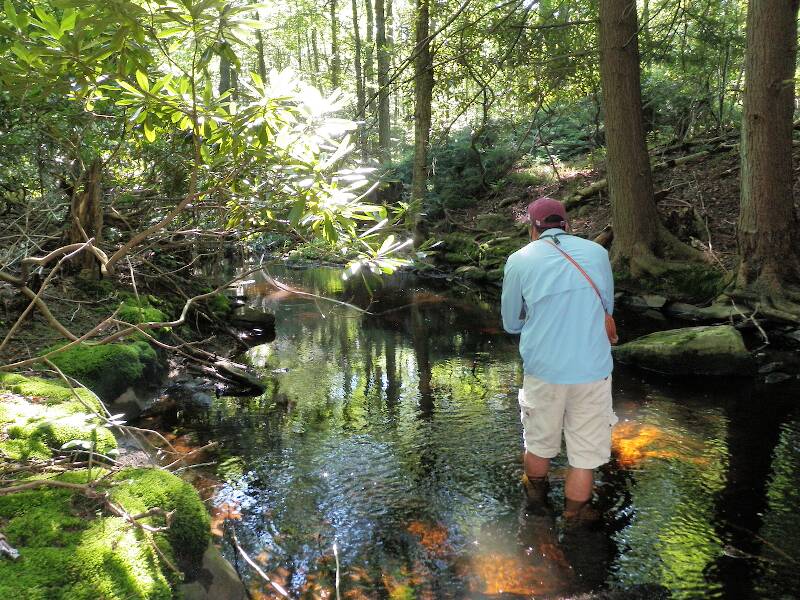
Hex Mayflies
Hexagenia limbata
The famous nocturnal Hex hatch of the Midwest (and a few other lucky locations) stirs to the surface mythically large brown trout that only touch streamers for the rest of the year.
Featured on the forum

This is an interesting one. Following the keys in Merritt R.W., Cummins, K.W., and Berg, M.B. (2019) and Jacobus et al. (2014), it keys clearly to Ephemerella. Jacobus et al provide a key to species, but some of the characteristics are tricky to interpret without illustrations. If I didn't make any mistakes, this one keys to Ephemerella mucronata, which has not previously been reported any closer to here than Montana and Alberta. The main character seems to fit well: "Abdominal terga with prominent, paired, subparallel, spiculate ridges." Several illustrations or descriptions of this holarctic species from the US and Europe seem to match, including the body length, tarsal claws and denticles, labial palp, and gill shapes. These sources include including Richard Allen's original description of this species in North America under the now-defunct name E. moffatae in Allen RK (1977) and the figures in this description of the species in Italy.

Troutnut is a project started in 2003 by salmonid ecologist Jason "Troutnut" Neuswanger to help anglers and
fly tyers unabashedly embrace the entomological side of the sport. Learn more about Troutnut or
support the project for an enhanced experience here.
Report at a Glance
| Dates Fished | Aug 15 |
| Time of Day | 11 to 2 |
| Fish Caught | 20-30 |
| Conditions & Hatches | Good volume for this time of year. Fished maintenance free (squeeze dry) dries. |
Details and Discussion
PaulRoberts on Aug 22, 2010August 22nd, 2010, 9:11 am EDT
August 18, 2010
In mountain country there are lots of little creeks draining all that convoluted topography, fed by snowmelt from the nearby high country making them all trout water; Another canyon, another creek, fed by numerous gulches. The particular little creek I fished today is about 2 miles from my door. As usual, there was nobody else there :). Small inhabitants and dense streamside cover appear to keep most anglers, esp fly-fishers, at bay.
My beat consisted of two stretches, only 2 miles apart, but brookie/rainbow water in the upper and brown trout water below. A thermometer will tell you where you are: 54F in the brookie water, 58F in the brown trout water. Volume is quite different, and this is important too as the browns grow faster and like the larger volume. This lower stretch was nearly double the volume of the upper, as I gain one stream order on descent from the upper.
I started at the lower stretch today, extending my known range into uncharted waters. Man I love little streams! Pool after pool, each one beautiful and challenging in its own unique way. I can literally go all day, and am disappointed when the earth rolls over and the sun disappears, or more often now, I have to meet another obligation.
These high gradient little creeks aren’t too challenging in the fly choice department: any old fly will turn a lot of heads. Insect activity does help of course, and I decide whether a given pool or fish warrants more attention to fly choice, but otherwise I’ll just pick a maintenance free fly and enjoy presenting it -5X and a #14 is fine. As I get to know these creeks better, specific activity will guide my stream time more I’m sure. I used a single RF (rabbit's foot) hopper/caddis the entire time.
I parked, dropped down the steep embankment, headed into the forest and hoofed downstream for quite a ways re-finding the stream at a nice narrowed deeply cut stretch with boulders alders and willow. Browns are pretty much everywhere a drift lane is provided. Because of the short drift lanes in such small turbulent water, casting is short and line is usually best kept off the water. Some larger pools do provide longer lanes and a good dump cast will get the job done. It sure is fun planning out the initial casts. Because of all the streamside cover, and the ease at which the fish spook, I position as best I can, usually at the tail, and pick away. My goal is to catch as many good ones from a given spot as possible. Some places only hold a single good trout. Catch it and there might be a little one for the next throw, but I most often move on.
Pools offer more, especially broad spreading ones that provide multiple drift lanes. They require some planning, and some luck, to eek out the better fish. The better browns, at the flow levels and insect activity I was working today, held off to the side of the main flow, and at cushions in the main current tongues. The head, and very end of the pool tailouts, most often held small fish today. Normally I'd try to catch these tailout fish and pull em down and out so as not to alarm the rest of the pool. But this is less an issue on such turbulent high gradient streams than it often is in flat water, where a single spooked 6inch trout can freak out the entire pool. In these steeper waters, a small trout zipping up doesn’t ruin the pool, in fact it can even help me out. Some of my better fish for the day came when I missed or pricked a fish which caused it to bolt. A shift then occurred in drift site occupancy, and several times during the day a larger trout dropped down to occupy a station near the tailout. The browns I caught averaged about 7 to 8 inches, the better fish were in the 10inch bracket, with two that touched 11inches.
Next I headed upstream to the upper stretch for brookies. My goal was to catch a decent photogenic brookie before I had to pick up my son from school. I found the upper stretch slightly diminished in flow from my last visit a couple weeks ago. I also found the trout stashed away in cover or beneath bubble curtains of the plunge pools, and spookier. I had covered a few runs and pools before I managed to bring anything decent to hand (not a 4incher). The first was a pretty 8+” ‘bow. Then, on the very last spot I was to fish before having to pull out and head home I found a good brookie.
It was in a smallish cut, but deeply shaded by willow and alder. The focal point was a 2 foot deep cut at the head that lay at the roots of an overhanging alder. The pocket was very short and turbulent just below. Together these made it difficult to get a fly into it drag free. But when I last visited I’d placed a couple small boulders below it to extend the laminar flow another couple feet, which allowed a drag-free drift long enough to cover the pocket. I crouched low and rolled my fly, a #18 olive parachute, into the pocket and a 10” (!) hen brookie snapped it up on my first drift through. I took a couple pics, and then hoofed out.

The "lower" stretch.

Those tangled shady tunnels hold browns!

Hey you! Quit pushin'!

Willows, alders ...and raspberries.

Stomach contents lol!

The browns are so beautiful I could photograph them all. But I don't. I just oooh and ahhhh, or just shake my head and turn em loose.




The "upper" stretch is brookie water and getting pretty small –about 6 feet wide here. But the densely shrub-lined banks keep the banks intact and confine the flow, offering good depth.


A 10inch brookie! Often fish at the top end of the length range for a given stream are thin. This fish was in nice condition. Might be worth perusing further. ;)
In mountain country there are lots of little creeks draining all that convoluted topography, fed by snowmelt from the nearby high country making them all trout water; Another canyon, another creek, fed by numerous gulches. The particular little creek I fished today is about 2 miles from my door. As usual, there was nobody else there :). Small inhabitants and dense streamside cover appear to keep most anglers, esp fly-fishers, at bay.
My beat consisted of two stretches, only 2 miles apart, but brookie/rainbow water in the upper and brown trout water below. A thermometer will tell you where you are: 54F in the brookie water, 58F in the brown trout water. Volume is quite different, and this is important too as the browns grow faster and like the larger volume. This lower stretch was nearly double the volume of the upper, as I gain one stream order on descent from the upper.
I started at the lower stretch today, extending my known range into uncharted waters. Man I love little streams! Pool after pool, each one beautiful and challenging in its own unique way. I can literally go all day, and am disappointed when the earth rolls over and the sun disappears, or more often now, I have to meet another obligation.
These high gradient little creeks aren’t too challenging in the fly choice department: any old fly will turn a lot of heads. Insect activity does help of course, and I decide whether a given pool or fish warrants more attention to fly choice, but otherwise I’ll just pick a maintenance free fly and enjoy presenting it -5X and a #14 is fine. As I get to know these creeks better, specific activity will guide my stream time more I’m sure. I used a single RF (rabbit's foot) hopper/caddis the entire time.
I parked, dropped down the steep embankment, headed into the forest and hoofed downstream for quite a ways re-finding the stream at a nice narrowed deeply cut stretch with boulders alders and willow. Browns are pretty much everywhere a drift lane is provided. Because of the short drift lanes in such small turbulent water, casting is short and line is usually best kept off the water. Some larger pools do provide longer lanes and a good dump cast will get the job done. It sure is fun planning out the initial casts. Because of all the streamside cover, and the ease at which the fish spook, I position as best I can, usually at the tail, and pick away. My goal is to catch as many good ones from a given spot as possible. Some places only hold a single good trout. Catch it and there might be a little one for the next throw, but I most often move on.
Pools offer more, especially broad spreading ones that provide multiple drift lanes. They require some planning, and some luck, to eek out the better fish. The better browns, at the flow levels and insect activity I was working today, held off to the side of the main flow, and at cushions in the main current tongues. The head, and very end of the pool tailouts, most often held small fish today. Normally I'd try to catch these tailout fish and pull em down and out so as not to alarm the rest of the pool. But this is less an issue on such turbulent high gradient streams than it often is in flat water, where a single spooked 6inch trout can freak out the entire pool. In these steeper waters, a small trout zipping up doesn’t ruin the pool, in fact it can even help me out. Some of my better fish for the day came when I missed or pricked a fish which caused it to bolt. A shift then occurred in drift site occupancy, and several times during the day a larger trout dropped down to occupy a station near the tailout. The browns I caught averaged about 7 to 8 inches, the better fish were in the 10inch bracket, with two that touched 11inches.
Next I headed upstream to the upper stretch for brookies. My goal was to catch a decent photogenic brookie before I had to pick up my son from school. I found the upper stretch slightly diminished in flow from my last visit a couple weeks ago. I also found the trout stashed away in cover or beneath bubble curtains of the plunge pools, and spookier. I had covered a few runs and pools before I managed to bring anything decent to hand (not a 4incher). The first was a pretty 8+” ‘bow. Then, on the very last spot I was to fish before having to pull out and head home I found a good brookie.
It was in a smallish cut, but deeply shaded by willow and alder. The focal point was a 2 foot deep cut at the head that lay at the roots of an overhanging alder. The pocket was very short and turbulent just below. Together these made it difficult to get a fly into it drag free. But when I last visited I’d placed a couple small boulders below it to extend the laminar flow another couple feet, which allowed a drag-free drift long enough to cover the pocket. I crouched low and rolled my fly, a #18 olive parachute, into the pocket and a 10” (!) hen brookie snapped it up on my first drift through. I took a couple pics, and then hoofed out.

The "lower" stretch.

Those tangled shady tunnels hold browns!

Hey you! Quit pushin'!

Willows, alders ...and raspberries.

Stomach contents lol!

The browns are so beautiful I could photograph them all. But I don't. I just oooh and ahhhh, or just shake my head and turn em loose.




The "upper" stretch is brookie water and getting pretty small –about 6 feet wide here. But the densely shrub-lined banks keep the banks intact and confine the flow, offering good depth.


A 10inch brookie! Often fish at the top end of the length range for a given stream are thin. This fish was in nice condition. Might be worth perusing further. ;)
GONZO on Aug 22, 2010August 22nd, 2010, 4:55 pm EDT
Man I love little streams!
Yeah, as much as I enjoy variety in my fishing, there's something very intimate and pure about fishing tiny waters. Lovely stuff, Paul. Thanks.
Shawnny3 on Aug 23, 2010August 23rd, 2010, 12:54 am EDT
Beautiful spot you've found, Paul. And what pretty fish! The colors on the second-to-last one almost can't be believed. It's rare when you catch a nice wild brookie that it isn't the prettiest fish you see that day.
-Shawn
-Shawn
Jewelry-Quality Artistic Salmon Flies, by Shawn Davis
www.davisflydesigns.com
www.davisflydesigns.com
PaulRoberts on Aug 23, 2010August 23rd, 2010, 4:55 am EDT
It's rare when you catch a nice wild brookie that it isn't the prettiest fish you see that day.
Yeah, she was almost an ugly brookie lol -if that's possible! She had very little color. Almost looked like a stocky -but I don't think that's the case here.
Martinlf on Aug 23, 2010August 23rd, 2010, 4:34 pm EDT
Great photos and narrative. Thanks for sharing your day with us.
"He spread them a yard and a half. 'And every one that got away is this big.'"
--Fred Chappell
--Fred Chappell
JohanB on Aug 26, 2010August 26th, 2010, 8:40 am EDT
Hey Paul!
Great pictures man! Sounds like you had a good time. I love fishing smaller streams it is very challenging and rewarding. Thanks for sharing!
Great pictures man! Sounds like you had a good time. I love fishing smaller streams it is very challenging and rewarding. Thanks for sharing!
Paradise Fly
Quick Reply
Related Discussions
Topic
Replies
Last Reply
6
Dec 23, 2007
by Krachen
by Krachen
Re: FINALLY one nice enough to take a photo or two of...plus wildflowers of course! 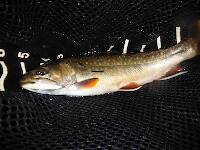
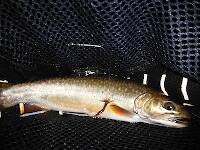

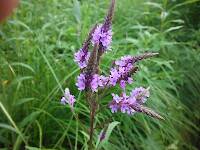

In the Photography Board by Jmd123
+ 2





In the Photography Board by Jmd123
4
Jul 24, 2014
by Motrout
by Motrout
Re: Fall kayak fishing for trout (and perch!!), plus a Spencer alert 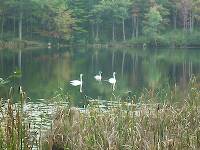
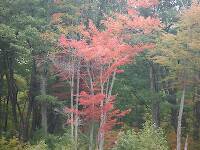
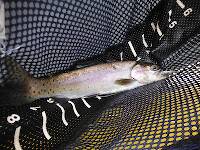
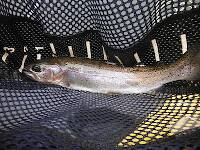
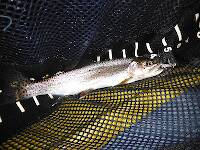
In the Photography Board by Jmd123
+ 1





In the Photography Board by Jmd123
2
Oct 6, 2015
by Oldredbarn
by Oldredbarn

